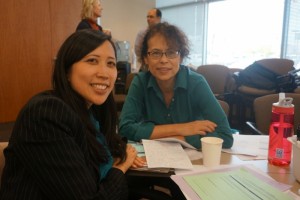
The training session on a rainy December 10th was a collaborative effort between the Sacramento County Office of Education (SCOE) and Public Advocates, created to develop school districts’ competency around sections 3A and 3B of the district’s spending and education plan known as the Local Control Accountability Plan (LCAP). In these sections, school districts describe how they plan to effectively spend supplemental and concentration funds awarded to school districts in proportion to state dollars generated by their numbers of foster youth, English learners, and students receiving reduced-price meals.
This training was a first-time collaboration between SCOE and Public Advocates, who both work to review district LCAPs and had identified a common need: Districts were struggling with how to explain in their LCAPs their spending of supplemental and concentration funds to increase and improve services for high-need students (Section 3A and 3B of the LCAP). Why not team up to provide a training?
The districts in attendance included Elk Grove, Folsom Cordova, Natomas, Sacramento City, San Juan, and Twin Rivers. A second training took place the following day for smaller districts in the county. Sitting classroom-style in “pods” and the golden-rod, lavender, teal and light green paper handouts all triggered strong flashbacks to my own K-12 education. And the training was not unlike a classroom lesson—part lecture and part practice. PA attorneys Liz Guillen and Angelica Jongco presented alongside experienced educators and SCOE leaders Sue Stickel and Jan Mayer.
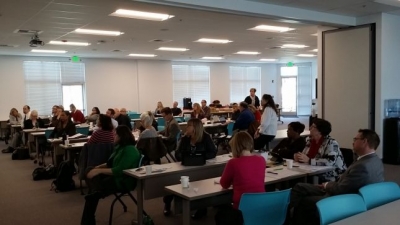
After Sue welcomed participants, district teams shared examples of how they were spending supplemental funds districtwide, including Teachers on Special Assignment, English learner support, a district office of equity position, anti-bullying programs, school climate, and programs promoting social and emotional well-being.
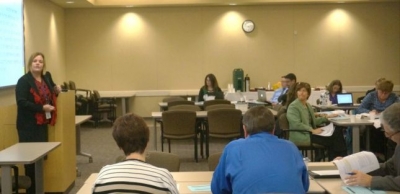
With these examples fresh in mind, Jan from SCOE walked through the instructions in the template for identifying and justifying districtwide and schoolwide spending of the supplemental and concentration funds generated by low-income, English learner, foster and homeless youth. She reviewed the specific language in the regulations and shared a handout for districts to use to make sure that they were applying the proper legal standard.Public Advocates then shared “Five Questions” to provide districts with a method to explain each of their districtwide and schoolwide expenditures in sections 3A and 3B sections to promote transparency and community dialogue. (These 5 questions can be found starting on Slide 14 of the presentation posted on SCOE’s website here and can also be found at the end of this post.) For each question, we showed one or two examples pulled from actual district LCAPs throughout the state.
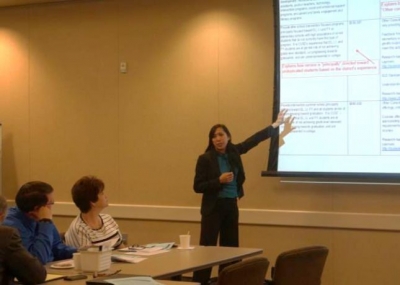
As with any good classroom lesson, participants had plenty of time for practice. District teams had the opportunity to apply the five questions to a sample Section 3A, using another handout. Then they analyzed section 3A and 3B of their own LCAPs for strengths and flaws and discussed how they might improve their LCAPs for next year.As Liz circulated the room, districts told her how helpful it was to have the 5 questions as a concrete tool to guide them through this previously mystifying section of the LCAP.
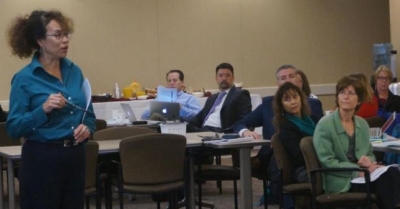
Transparency creates the opportunity for local accountability: at year end, school districts will have to assess their spending and whether or not it was effective. Also, where districts are clear about the how and why of their supplemental and concentration spending, community members can more easily engage in dialogue with the district about these uses and provide feedback on whether or not the district fulfilled their objectives for high-need students.This is the third year that the LCAP has been implemented and, based on several people’s remarks, there has been a lot of progress made since its hectic first year but it has been a bumpy ride. Working together, Public Advocates and the Sacramento County Office of Education provided support with the hope that the next LCAPs that school districts develop with their community stakeholders are significantly more transparent in their plans to improve services for high-need students in Sacramento County.
The author Erin Paxson is a student law clerk with Public Advocates and a sophomore at Lawrence University in Wisconsin.
FURTHER RESOURCES:
The Complete Slides and Resources from the Training Can be found on SCOE’s training page.
Further information & resources on the LCAP and the Local Control Funding Formula.
Five Questions to Ask About Proposed Districtwide/Schoolwide Use of Supplemental & Concentration Funds:
- Are the proposed use of funds “principally directed” toward meeting the goals that the district has set in its LCAP for high need students (low-income students, English learners, foster youth, and homeless students? In other words, a forethought, not an after thought or an equal thought?
- Can the proposed use of funds be demonstrated (by past experience, research or theory) as an “effective” use of funds for serving the district’s goals for high need students?
- If the population of high-need students in the district is <55%, or in the school is <40%, is the decision to provide the districtwide or schoolwide service the most effective use fo the funds, including compared to more targeted programs? Does the LCAP provide the basis for this “most effective” determination including alternatives considered, supporting research, experience or educational theory.
- Does the proposed use of funds increase or improve services for high-need students (i.e., does it “grow services in quality” or “quantity”)?
- Over the level of services provided to high-need students in the last year (for new supplemental & concentration dollars) during the transition to full LCFF implementation
- Over the level of services provided to all students for the LCAP year?
- For annual updates and future LCAP adoptions, after a reasonable time for implementation:
- Did the investment result in an increase or improvement in services in terms of program quantity or quality as promised?
- Was it effective (or, for low-concentration schools/districts, the most effective use) in improving outcomes in the intended priority area?

